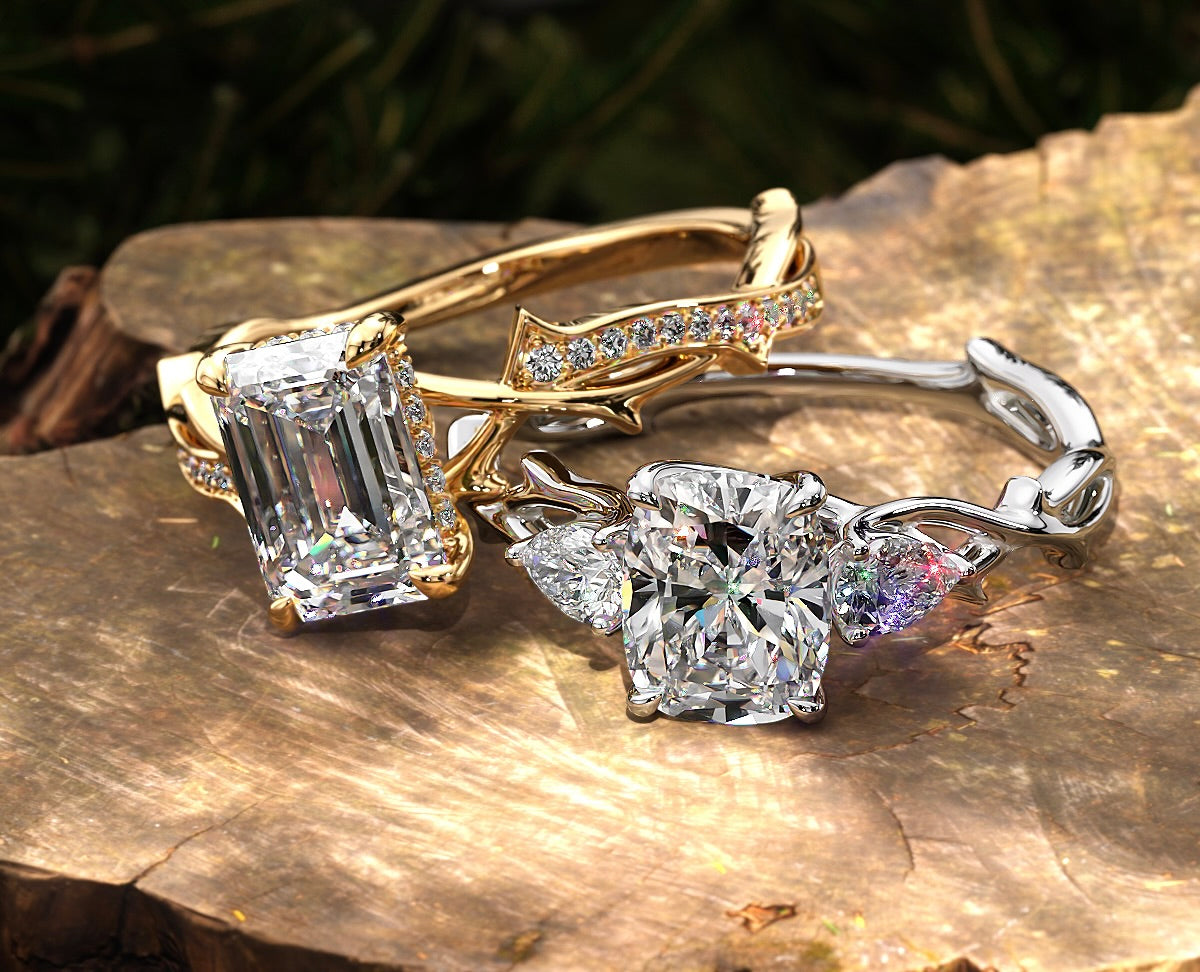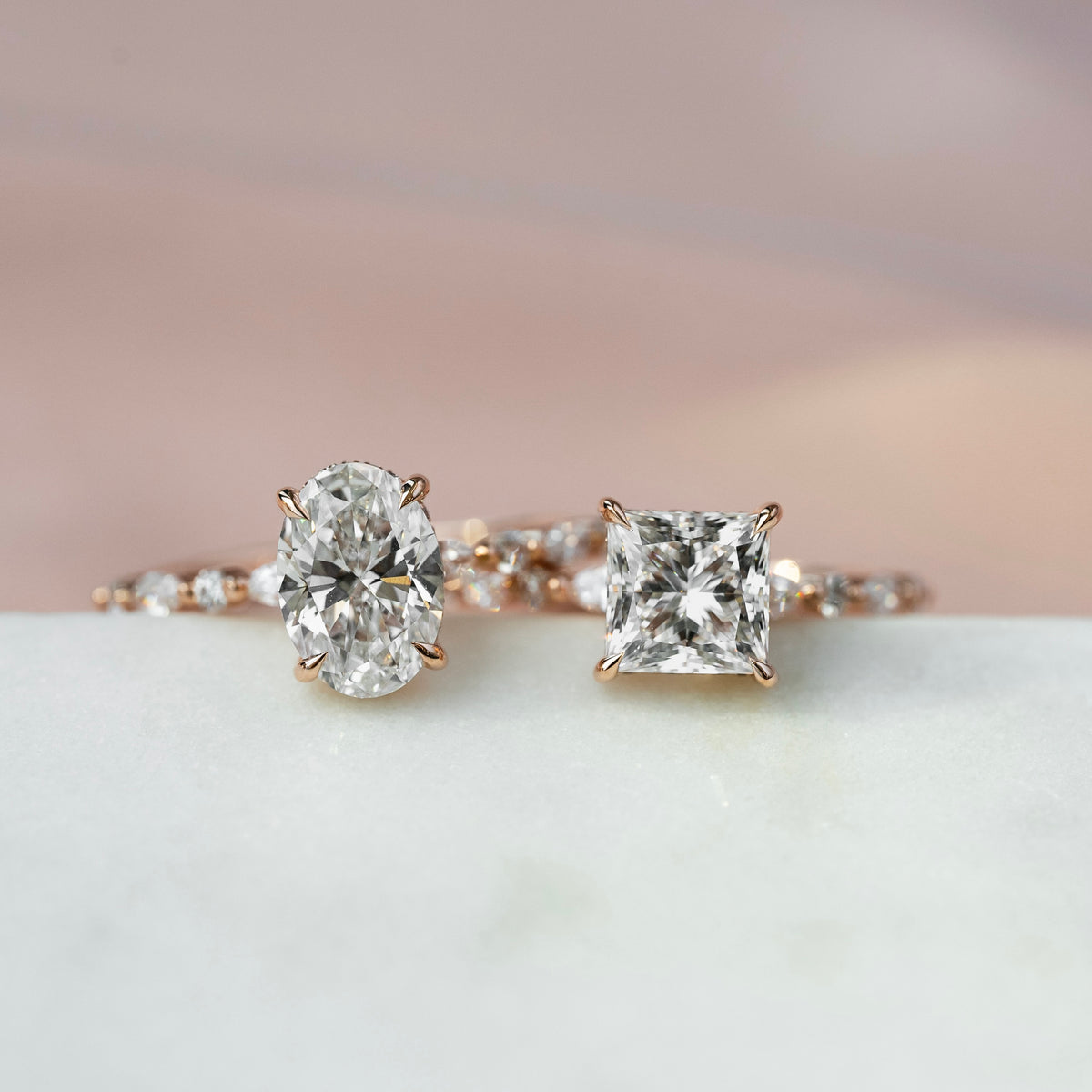A More Eco-Conscious Alternative
Because it’s created in a lab, moissanite avoids the problematic issues tied to gemstone mining, and the devastating effects that mining has on our environment and its inhabitants. Moissanite has a smaller carbon footprint than mined gem stones or diamonds, making it a more sustainable and responsible choice.

What is Moissanite?
Moissanite is a gemstone derived from stars. It was discovered in 1893 by Henri Moissan, a French scientist who went on to win the Nobel Prize for Chemistry. He discovered minuscule pieces of the gem that would later bear his name in Arizona, in a crater formed by a meteorite that crashed to Earth. He initially believed he had discovered diamonds, but later realized that the crystals were made of silicon carbide.
Because natural moissanite is extremely rare, most moissanite on the market today is synthetic. After many years of trial and error, Moissan's particles were successfully synthesized into one of the world's most brilliant jewels.
Moissanite, often known as a diamond simulant, is designed to provide the appearance of diamond resemblance while being chemically and optically distinct from a real diamond. The durability, brilliance, and color of the two jewels are significantly different. Diamonds and moissanites both have a high heat conductivity.

An eco-friendly, long-lasting, and reasonably priced substitute for a mined diamond
Moistanites require no mining at all because they are developed in carefully regulated conditions with cutting-edge technology. Moissanites produce less of an environmental impact and have a lesser carbon footprint than natural gemstones. Investing in fine jewelry crafted from moissanites is a wise decision.
Moissanite gemstones are produced to an Excellent Cut and are colorless (rated D, E, or F). They also have excellent clarity (VS1 or greater). Because moissanite is less brittle and has a higher tensile strength than diamonds, it is less prone to chipping and cracking.

Selecting a Moissanite
Cut, color, clarity, and carat (the four Cs) determine a diamond's cost and worth. Together, these components give the stone its beauty and brilliance.
The degree of cut and clarity is consistent across various moissanites. Additionally, Moissanite comes in colors that correspond to the "Colorless" D through F range and the "Near Colorless" G to I range. The finest quality stones currently on the market are found in all of MSBLUE Jewelry's moissanites and moissanites engagement rings. They promise to have VVS1 clarity or greater and DEF color.
Why Choose Moissanite?
Moissanite vs. Diamond
-
Moissanite
Composition: Composed of silicon carbide, moissanite is a naturally occurring mineral found in limited quantities on Earth, but most moissanite used in jewelry is lab-created.
Hardness: Second only to diamonds in hardness on the Mohs scale, moissanite scores 9.25, making it highly durable and resistant to scratching or chipping.
Brilliance and Sparkle: Moissanite: Known for its exceptional brilliance and fire, moissanite exhibits a dazzling sparkle due to its high refractive index, dispersing light into colorful flashes.
Color: Moissanite: Generally, moissanite exhibits minimal to no color and is graded on a color scale from D to K, with D being colorless and K showing slight yellow or gray undertones.
Cost: Moissanite: Moissanite is typically more affordable than diamonds of comparable size and quality, offering an excellent alternative for those seeking brilliance without the high cost.
Origin and Sustainability:Moissanite: Most moissanite available today is lab-created, offering an eco-friendly and sustainable alternative to mined gemstones.
Popularity and Tradition: Moissanite: Growing in popularity as an alternative gemstone for engagement rings and fine jewelry, moissanite offers a modern yet timeless choice for those seeking brilliance and affordability.
-
Diamond
Composition: Comprised of carbon atoms arranged in a crystalline structure, diamonds are formed deep within the Earth's mantle over millions of years.
Hardness: Diamonds are the hardest natural substance, scoring a perfect 10 on the Mohs scale, making them extremely durable and ideal for everyday wear.
Brilliance & Sparkle: Renowned for its unmatched brilliance, diamonds disperse light beautifully, resulting in a captivating sparkle with a play of light known as "diamond fire."
Color: Diamonds come in a range of colors, from colorless (D) to light yellow or brown, with color grades affecting their value and rarity.
Cost: Diamonds are traditionally more expensive due to their rarity and demand, with factors such as cut, color, clarity, and carat weight influencing their price significantly.
Origin & Sustainability: Mined diamonds have raised concerns regarding environmental impact, labor practices, and ethical sourcing, although efforts are being made to promote responsible mining practices and traceability.
Popularity and Tradition:Diamonds have long been synonymous with luxury, romance, and tradition, making them a popular choice for engagement rings and special occasions for centuries.

Moissanite
Brilliance & Fire
Moissanite has a higher refractive index than a diamond, meaning that when light enters a moissanite stone, it will bend more than within a diamond. This means there will be more small flashes of white light (brilliance) and greater levels of dazzling colour (fire).
When exposed to sunlight, a moissanite stone will sparkle brightly and may exhibit a rainbow, almost “disco-ball” effect. Compared to a diamond’s subtle blue-grey kaleidoscope pattern, moissanite’s sparkle is brighter and more dazzling – often the very quality that our clients fall in love with
Moissanite FAQ's
How do we make our Moissanite jewelry?
Out Moissanite jewelry is crafted through a process involving the creation of synthetic moissanite crystals using methods like high-pressure,high-temperature or chemical vapor deposition. Skilled artisans then cut and shape the moissanite, grade its quality based on color, clarity, and cut, and set it into various jewelry pieces. Quality control ensures standards are met,and final finishing touches, such as polishing, are applied before packaging for retail. The process emphasizes replicating the brilliance and fire of the gem, resulting in attractive and durable moissanite jewelry ready for the market.
Why choose Moissanite jewelry?
Moissanite jewelry is way more affordable than diamond jewelry. So, you can get the same ring in 9ct gold, 18ct gold, or platinum for much less money. Or, if you prefer, you can choose a bigger stone for a lower price.
In short, people usually go for diamond jewelry, like engagement or wedding rings, but diamonds are really expensive. Moissanite is a fantastic alternative because it looks a lot like a diamond but costs way less.
Even though moissanite is just as strong and beautiful as a diamond, if not more, and more and more people are starting to like it, it's hard to say for sure if it will be the next big thing. But, looking back, emeralds used to be as popular as diamonds are now.
Is Moissanite environmentally friendly?
Moissanite is made in a lab, so there's no need to dig it up from the earth. Making these gems doesn't harm the environment and avoids problems with conflict trade. Compared to natural gemstones, moissanite's origins are easy to trace and completely eco-friendly. So, when you wear your beautiful new jewelry, you can feel good knowing exactly where it comes from. (Flawless Moissanite takes it a step further by using recycled Gold in all our Gold products for extra peace of mind.)
Is moissanite as good as a diamond?
Moissanite is the only gems to that passes as a diamond on a handheld point test. If you want a stone that resembles a diamond without a high price, moissanite is a great option. At the end of the day, preference comes down to personal taste.
Is moissanite durable?
Moissanite is one of the toughest known gemstones which makes it perfect for an engagement ring, a piece of jewelry that is usually worn every day. Studies in high pressure research have shown that moissanite stone is highly resistant to breaking and chipping.
Does moissanite lose its sparkle?
Moissanite will not lose its sparkle as time passes. The clarity and color of the stone won’t change through the years. Dirt and grime are the only common elements that may inhibit a ring’s sparkle until it is cleaned. Damaging the surface of moissanite can inhibit sparkle, as it would for any gemstone.




